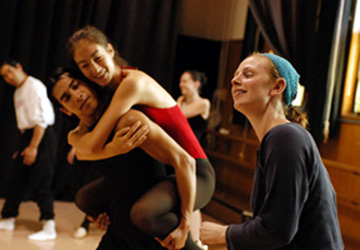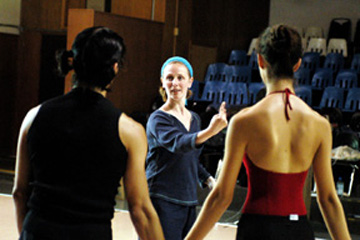| Preview:
Midsummer
Night's Dreaming
An
interview with Julie Adam
by
Rita Felciano
With
a whole slew of impressive works to her repertoire,
among them her latest, the fresh and slightly idiosyncratic
imaginal disc premiered by San Francisco Ballet
last season, Julia Adam can no longer be considered
a newcomer to the rarefied world of ballet choreography.
Like many of her colleagues, she has been making pieces
that fit into the repertory programs favored by ballet’s
artistic directors these days: dances that use between
a half-dozen to perhaps fifteen dancers and are about
twenty to thirty minutes long.
 But
ballet companies also have a tradition of full-evening
works and typically have much larger ensembles at their
disposal than those deployed in short, contemporary
pieces. So how will a ballet choreographer learn the
skills to handle larger groups and a more expansive
time frame, in short how to create a trajectory longer
than half hour? Few freelance choreographers get the
opportunity to learn the necessary skills early in their
career. Many of them have to tackle the task for the
first time when they are artistic directors and have
to answer the clamor for full-evening works. But
ballet companies also have a tradition of full-evening
works and typically have much larger ensembles at their
disposal than those deployed in short, contemporary
pieces. So how will a ballet choreographer learn the
skills to handle larger groups and a more expansive
time frame, in short how to create a trajectory longer
than half hour? Few freelance choreographers get the
opportunity to learn the necessary skills early in their
career. Many of them have to tackle the task for the
first time when they are artistic directors and have
to answer the clamor for full-evening works.
That’s why Julia Adam’s current project, A Midsummer
Night’s Dream, which will premiere August 2 at
the Marin Fine Arts Theater in Kentfield, was such an
intelligent choice on her part. Conceived as a three-year
project, she plans to expand the piece over the next
two years until she has created a full-evening, about
an hour and a half long, which could become Marin’s
Nutcracker. Set on the advanced students of Marin
Ballet’s summer program, this first phase of the work
is fifty minutes long and, according to Adam “uses just
about everything” of the classic Mendelssohn score.
Taking it in stage has allowed Adam to develop the kind
of structures she’ll need to sustain interest for a
whole evening. While for the moment she is concentrating
on the task at hand, she is already thinking about how
the project might evolve. “I may want to work with text
and singing and bring in a children’s theater company
and a chorus and make this into one massive party,”
she laughed, adding quickly “but then who knows what
will happen.”
The project came about because Marin Ballet’s artistic
director Cynthia Lucas was a soloist at the National
Ballet of Canada at the time Adam joined that company.
The two of them have stayed in touch, and it’s clear
from watching them work together that they have a close
relationship. “Cynthia is an absolutely fantastic teacher,”
Adam says admiringly. “She really is my mentor. I had
many private lessons with her and worked closely with
her for a year before I joined San Francisco Ballet.
She taught me everything—like turn out and how to get
on pointe.”
 Lucas
suggested working with the Marin County students this
summer, and Adam jumped at the idea of realizing a project
she had thought about for several years. With forty-four
dancers, this is by far largest ensemble with which
Adam has worked. “We’ll have a lot of trees, and saplings
and bushes, and butterflies, ” she says. Since there
are no men, she is hiring three ODC men, Justin Flores,
Brandon Freeman and Daniel Sanchez for the parts of
Bottom, Lysander and Demetrius. Oberon will be a speaking
part performed by an actor from the Marin Shakespeare
company. Marin Ballet did some special-project fundraising
which allowed the company to hire professional costume
(Christine Darch) and lighting (Lisa Pinkham) designers. Lucas
suggested working with the Marin County students this
summer, and Adam jumped at the idea of realizing a project
she had thought about for several years. With forty-four
dancers, this is by far largest ensemble with which
Adam has worked. “We’ll have a lot of trees, and saplings
and bushes, and butterflies, ” she says. Since there
are no men, she is hiring three ODC men, Justin Flores,
Brandon Freeman and Daniel Sanchez for the parts of
Bottom, Lysander and Demetrius. Oberon will be a speaking
part performed by an actor from the Marin Shakespeare
company. Marin Ballet did some special-project fundraising
which allowed the company to hire professional costume
(Christine Darch) and lighting (Lisa Pinkham) designers.
Working with students, even pre-professional ones as
many of these young women are, had its own set of challenges.
But since Adam had her first training at her mother’s
ballet school, she’d stepped into familiar territory.
“I knew that I couldn’t really experiment with steps
since these are students,” she explained. She also knew
the limitations of working with potentially gifted,
but very young, dancers. “What I want them to see is
how the process of making a piece works. So I tell them
to move over to the right for now but that tomorrow
I may change my mind.”
During a rehearsal, ten days before the premiere, Adam
was remarkably calm and didn’t seem to mind the sometimes
not terribly relevant seeming questions. She answered
them quickly and went on, explaining, demonstrating
and watching. With a notebook in one hand, a pencil
in another, she masterminded the twenty-two “trees”
from various “grove” formations of small circles into
a large circle that moved around Titania and her attendants.
The steps were straightforward temps levé, tombé,
walk, walk, walk but layered in such a way that they
created texture and rhythm. “The trick,” she explained
later, “is to keep it simple enough”. At one point she
had four circles, with Titania at the center, going
simultaneously, each in a different patterns. It looked
like a lens that opened and closed to generate various
depths of field.
The students, some of whom wore color patches pinned
to their leotards—“it helps me to keep track of who
is a flower and who butterfly”—were remarkably concentrated,
and it looked like all of the school’s teachers were
present and took notes so that they could work on individual
issues outside the formal rehearsal process.
Even at this stage, the choreography is musical, emotionally
nuanced, and full of lovely little touches. Titania’s
attendants who curl around her while she is asleep become
spokes in a wheel with her in the center. Their expressions
of dismay at the queen’s hilarious, yet tender duet
with the ass look like it might have been inspired by
the kind of whispering that goes in a school playground.
Appropriate for Titania, who fights with her husband
about the changeling boy, described by Shakespeare as
“oriental”, the choreography for her uses a flat plane.
The wood becomes alive with a nervous, even anxious
expectation, at the arrival of this noble intruder.
The final procession—highly formal with its serpentine,
circle and mirrored line formations—is not without its
humor. At one point, Mendelssohn repeats a piece of
music; it sounds as though he wants to start over. Adam
used it have a dancer rush in overly eager to pay obeisance,
only to have to withdraw and come in with her companions.
This A Midsummer Night’s Dream already looks
like a winner all the way around. It gave Adam an opportunity
to create on a scale she has never done before and the
students to work with a gifted artist and see how a
piece of choreography comes into being. Not a bad way
to spend your summer.
Photos
of Adam and students of the Marin Ballet rehearsing
by Marty Sohl.
|